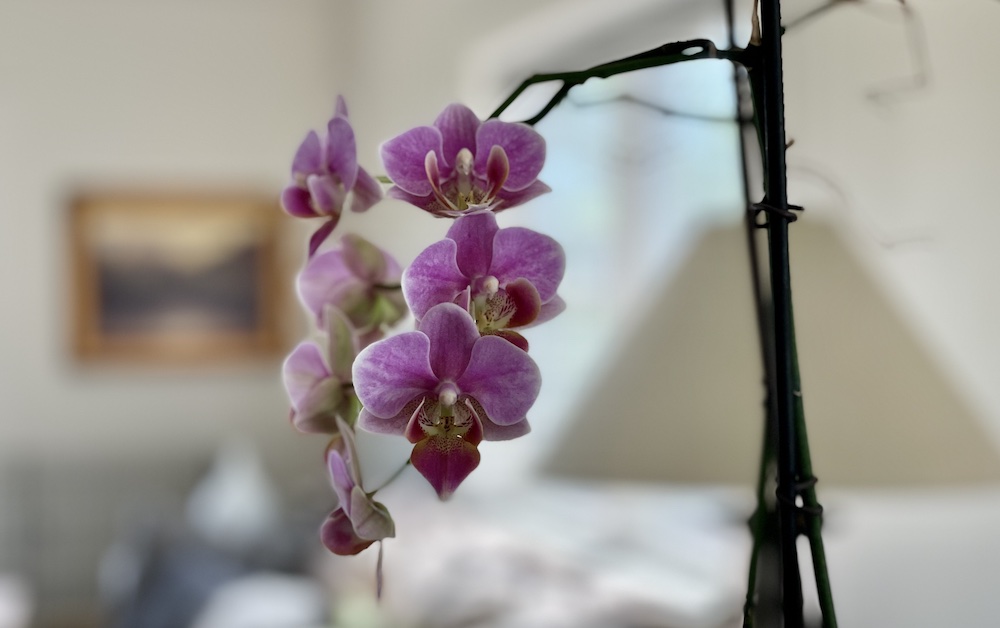The U.S. Environmental Protection Agency estimates that indoor air quality is often up to 10 times worse than what’s outside – and our studios are even worse than that – but, houseplants can help!

Did you know houseplants can actually benefit our lives and help keep it green?
For only pennies a day, houseplants will help beautify, purify and renew your stuffy studio, office or home by filtering out toxins, pollutants and the carbon dioxide we exhale and replaces them with fresh oxygen!
Besides this, all plants add moisture to the air, and can even help prevent dry skin and sore throats in the winter.
NASA began testing common house plants for their capacity to purify indoor air.
A NASA research document found that, “House plants can purify and rejuvenate the air within our houses and workplaces, safeguarding us all from any side effects connected with prevalent toxins such as formaldehyde, ammonia and also benzene.”
The following toxins and other materials are known to cause “off-gas” pollutants into the interior environment include:
- man-made building materials
- synthetic carpeting
- formaldehyde (often found in new rugs and vinyl as well as cigarette smoke and even grocery bags!)
- fabrics
- benzene, a known carcinogen
- laminated counters
- plastic coated wallpaper
-
household cleaners
-
pesticides
-
paints
-
adhesives
- printers, copiers and fax machines
- electromagnetic radiation
Here is a list of Green Clean houseplants to help combat the above and get you started:
Areca Palm Tree
The Areca palm tree is the very best air purifying plant according to the ratings from NASA’s research and has the 8th highest removal rate for Formaldehyde. This houseplant was referred to as “the most effective air humidifier”.
During the winter season, it’s so effective at putting moisture back in the air that you could switch off your electric humidifiers!
Lady Palm
This houseplant achieved exactly the same rating as the Areca Palm tree in NASA’s research.
Bamboo Palm
This palm was the third most powerful plant at removing formaldehyde. This palm will require lots of room to grow, so it might not be the best option if want this plant to sit on your desk.
Boston Fern
The Boston fern is effective plant at removing Formaldehyde significantly more per hour than the rest of plants examined. The Boston fern will also eliminate heavy metals, such as mercury and arsenic from the soil.
Rubber Plant
The rubber houseplant provides moisture, eliminates bio effluents, takes away volatile organic compounds. It also suppresses air based microorganisms as soon as it’s put into a room.
Dracaena
These plants are especially effective in newly carpeted or newly furnished rooms were formaldehyde levels are at the highest.
English Ivy (poisonous)
English Ivy is a solution for allergic reactions observing that sixty percent of air based mold within the space was removed after just six hours right after English ivy had been introduced. People that have allergies, asthma, or even the desire to inhale cleaner air will enjoy this plant.
Ficus Alii
This plant is an excellent addition to any kind of office or home wherever clear air is missing. Be sure and wear hand protection when dealing with the house plant for those who have latex allergic reactions.
Spider Plant
In a room with many spider houseplants the amount of carbon monoxide and nitrogen dioxide dropped to near zero after only 24 hours.
Chrysanthemum (poisonous)
Brighten your studio or office with color and remove the VOC compound – benzene, which has been known to cause cancer! Many tobacco products contain high levels of benzene.
One of these plants in a smoking household would be helpful but, no house plant can ever negate the effects of tobacco smoke. Chrysanthemums are poisonous when ingested or with prolonged skin exposure.
Heart Leaf Philodendron (poisonous)
NASA showed the Philodendron house plant as one of the best house plants for elimination formaldehyde from the surrounding air. These easy to grow vines have been proven to help remove formaldehyde fumes from the air. They make great climbing and hanging plants.
Snake Plants aka Mother in Law Tongue
This plant is a good remover of formaldehyde and xylene from the surrounding atmosphere and it also removes ammonia.
Peace Lily aka Mauna Loa
In need of an air purifier plant but you don’t have green fingers? This is the perfect plant for you. Peace Lilies are often found in malls because they are so easy to grow
Aloe Vera (poisonous)
This healing plant has proven to be a lot more effective at the elimination of formaldehyde at lesser concentrations when compared with Philodendrons. Aloe vera is likewise acknowledged for its therapeutic qualities, giving it the majority of its nicknames.
Caution should be exercised before using Aloe from an Aloe plant because contact dermatitis can occur in sensitive individuals. Beware, ingestion of the latex, which is found just under the skin is dangerous.
Phalaenopsis
A member of the orchid family, this houseplant cannot tolerant direct sunlight which makes it great for lowlight studios or offices. You can place this beautiful houseplant in the artificial light in your house.
African Violets
The charming African violets are available in a variety of colors, shapes and sizes. To propagate these houseplants, all you need is leaf cuttings. These plants grow easily in moderate light and temperature.
Gerbera Daisies
Feston Rose
The most greatest feature of this plant are its flowers of variegated colors which leaves the house, office or studio smelling fresh and also removes impurities from the air.
The NASA studies generated the recommendation that you use 15 to 18 good-sized houseplants in 6 to 8-inch diameter containers to improve air quality in an average 1,800 square foot house. The more vigorously they grow, the better job they’ll do for you. There should be 1 plant per 100 square feet of your home.
*****
* An artist should also consider using activated carbon air purifiers to absorb toxic paint fumes. Lifelong exposure to chemicals, heavy metals, fumes and air borne particles can create serious health problems and health risks for artists. Artists tend to absorb the chemicals they use in small doses. This chronic, low-level poisoning can be avoided with the proper air purifiers.
You might also like some of these other interesting posts:
5 Unique Ways to Brainstorm out of a Creative Rut
6 Ways to Keep Your Goals to Yourself to Achieve Them
10 Ways to Overcome Mental Blocks and Boost Creativity
How to Find Your Own Artistic Voice
Save Money. Learn How to Gesso a Hardboard Panel for Painting
Bringing the Still Life to Life: A Painting Demo by Master, Jeff Legg
The New Still Life Paintings of Lori McNee
All plants help to purify the air we breathe. To read more about air purifying plants, please check out the experts:








Hi Lori! Thanks for this informative post. It’s too bad I’m terrible with plants, otherwise I’d put it to use. The only house plant I have is one that’s been with me for nearly seven years now and can survive very intermittent watering and irregular lighting! I just can’t seem to keep plants alive, but I’ll have to give it another go after reading this!
Hi Miranda…good to see you comment again.
Some of those plants listed are fairly easy to grow. I like low mantaince plants myself… But as we have learned, adding a living plant is healthy for the air we breathe, not to mention it adds some life to a lonely studio!
Best-
Lori 🙂
I needed to know this! Thanks for posting!
Glad you liked this info…I found it helpful too 🙂
Hey great info! I don’t have a green thumb to do this though. Could you point out which ones are low maintenance. That will be such a great help!
Mam, thank you for more post about the names of different plants and its respective names. You know I have it already but I do not know their names.
You are very welcome Isaias. I am happy this post helped you!
Best-
Lori
Just got our first home, thanks very much Lori for this list!
Congrats on your first home! Houseplants will make it even more beautiful 🙂
Lori
There are so many easy to grow, house plants, that basicly anyone can have green plants inside….I love my plants, always have a few around..
Thank your for the added information. I love my plants too…
I appreciate the comment, Alan.
Cheers-
Lori
Thank you so for sharing this information. I’m using this information for making a website on indoor plants for my school project.
You are so very welcome Chandukamar, I am so happy this helped you.
Lori 🙂
This is a great and informative post. Glad I stumbled upon it! I’m an oil painter and I use lots and lots of solvents (but I at least try to used the “safer” slow evaporating solvents). Do you recommend any plants in particular for outfitting a painter’s studio?
Thanks!
Well, I wouldn’t only rely on houseplants to purify your studio air. Vapors and toxic fumes are too strong for plants to clean. That said, plants do help produce fresh air. I would suggest adding an air purifier if you are dealing with a lot of toxicity.
Cheers,
Lori
This is great!!! I love plants!
Great article.
With the air purifier system of pollusan, the air filtering is 10 times more effective.
Hi Helge, thanks for sharing your link with us. I’ll check it out!